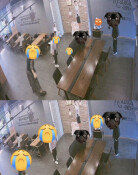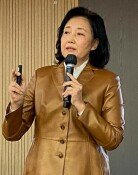[Editorial] Gwanghwamun Plaza
Gwanghwamun Plaza was in a festive mood throughout the weekend. Hundreds of thousands of people visited the plaza to look at the capitals newest attraction with delight. Children cooled off at a fountain near the statue of legendary admiral Yi Sun-shin. The plaza is also directly connected to an exit of Gwanghwamun subway station and the northern end is connected to Gwanghwamun, a traditional gate under restoration. In the backdrop stands Mount Bukak, which is often called Seouls guardian mountain.
Gwanghwamun Plaza had its grand opening Saturday. The area has long served as the heart of Korean history and politics since the Joseon Dynasty. Gwanghwamun is the southern gate of Gyeongbok Palace and has government offices on both sides of the southern end. The main street was called Yukjo, a bustling commercial street in the days of the dynasty. Having served as a symbol of politics and authority for 600 years, Gwanghwamun has been reborn as a place to relax and take a walk.
The Seoul Metropolitan Government made sure the plazas design emphasized the areas historical aspects. For example, it placed the statue of King Sejong together with the statue of Admiral Yi, two of the countrys most revered figures. In 1425, King Sejong renamed the gate from Sajeongmun to Gwanghwamun, which means the Kings virtuous light shines on the nation. The statue of King Sejong will add significance to the plaza.
Seoul Mayor Oh Se-hoon said on opening day, The plaza will become a landmark of Korea that represents national identity like the Champs-Elysees in Paris. There is, however, room for improvement. The number of lanes was reduced from 16 to 10 at Sejong Street to make room for the plaza, leading to heavy traffic congestion over the weekend in downtown Seoul. The plaza has several spots that block the sun, but not enough to accommodate most visitors.
The plaza should also not degenerate into a place for illegal demonstrations. Government institutions and the U.S. Embassy are nearby, and Gwanghwamun Plaza is closer to the presidential office of Cheong Wa Dae than Seoul Plaza. The city has banned political assemblies at the new plaza and will impose stricter regulations on such gatherings than for Seoul Plaza. Yet certain groups have repeatedly staged political demonstrations at Seoul and Cheonggye plazas under the disguise of cultural events, and whether the city can stop them from doing so at Gwanghwamun Plaza is unclear.
If Gwanghwamun Plaza is to truly become a Korean landmark, it should establish itself as a public place for relaxation and culture. If it turns into a venue for illegal protests like the candlelight vigils that paralyzed Seoul between May and August last year, the city is better off without the plaza. The city government and residents should work together to make Gwanghwamun Plaza a place for comfort and peace and free from illegal protests and political actions.







